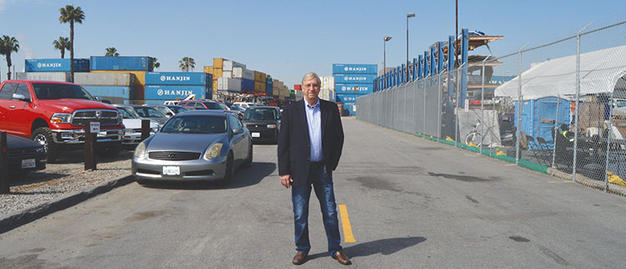Westside businessmen Stan Janocha and Daryl Phillips each filed appeals against the Port of Long Beach’s proposed Pier B On-Dock Rail Support Facility Project, claiming its negative impacts on Westside businesses would be extreme. During a hearing on March 20, the Long Beach City Council denied the appeals, giving the port the green light to move ahead with the early planning stages of the project.
Janocha is chief operating officer of Superior Electrical Advertising and Phillips is the owner and president of Phillips Steel Company, two prominent businesses on the Westside. Their appeals against the project’s environmental impact report (EIR) claimed the project would create unnecessary burdens on Westside businesses in the form of increased air and noise pollution, among other issues. Janocha pointed out the EIR clearly states air quality around the project would be significantly adversely affected.

This March 2017 Business Journal photograph shows Superior Electrical Advertising COO Stan Janocha on a road in the Westside. On the right is Superior’s property. The parking lot on the left will become part of the Pier B Rail Facility. Janocha is worried about the impact the project’s proximity will have on his business. (Business Journal Photograph by Larry Duncan)
“It was very disappointing and frustrating. It seems like every councilmember and the mayor had made up their mind long before the meeting. I don’t think they really listened to us and I don’t think they addressed the issues on the Westside,” Janocha told the Business Journal. “I’m not just talking about the businesses, I’m talking about the residents. There are schools and residents that are right across the L.A. River.”
After an eight-year process and around 300 comment responses, the port project was approved by the Long Beach Board of Harbor Commissioners on January 22. Deputy City Attorney Dawn McIntosh, who specializes in environmental law, contested that the EIR addressed all areas of the appellants’ concerns adequately and in accordance with California Environmental Quality Act requirements.
Superior Electrical has operated in Long Beach for over 60 years and occupies a 50,000-square-foot building with a 50,000-square-foot adjoining lot used for equipment and product storage. The rail yard will be approximately 125 feet from Superior Electrical’s property, which Janocha said will create a poor work environment for his 125 employees. Though he said the company would survive, Janocha said he was not sure if it would remain in Long Beach.
City staff estimated that approximately 40 businesses would be directly impacted by the project and made to relocate. Though his business is not within the project’s footprint, Phillips said the Westside as a whole would feel the adverse effects of the rail yard. Phillips Steel has been in Long Beach for over 100 years, and Phillips provided the following statement to the Business Journal after the council’s decision:
“I am deeply saddened that the city and port are moving forward with an expansion plan that they clearly admit will detrimentally increase toxic pollution and environment setbacks to not only our community but surrounding cities as well. The proposed plan admittedly creates new levels of toxic pollution and health problems, and the burdens associated with the expansion [are] on those too poor or too conflicted to fight back. Clearly there will be increased cases of asthma and cancers, and high levels of noise pollution up to 152 decibels, [which] train horns [produce], can blow out eardrums, as the expansion directly abuts the Long Beach Health and Human Services Multi Service Center, which cares for school children on a daily basis, and my business.”
Janocha, Phillips and other Westside business operators are seeking legal counsel to determine if there are additional measures they can take in their attempt to derail the project.
Tiffany Rau, public and government affairs representative for refining company Andeavor, spoke during public comment on behalf of Tesoro SoCal Pipeline Company LLC, an Andeavor operation at the port. During her time, Rau said the company supports the rail project but shares some concerns with the appellants. Andeavor’s main concern is the project could require the removal or relocation of more than 200 utility pipelines, including 15 oil pipelines operated by the company.
“We’re committed to working with the port to resolve our concerns,” Rau said. “Removal of hundreds of utility lines could result in significant disruption of the port’s operations and these disruptions would also directly affect our operations, our customers, public utilities and numerous other operators at the port.”
The project will increase on-dock rail support from 12 to 48 tracks in an effort to increase the amount of cargo transported by train, which would decrease the number of trucks on the road. Currently, approximately 25% of cargo is transported by train, and the port’s goal is to increase that number to 35%. The three-phase, seven-year project would create 1,100 construction jobs and includes a $1.5 million contribution by the port to the port’s community grant program.
The port’s next step is to create a budget for the Pier B program to be presented to the board of harbor commissioners in May, according to Lee Peterson, media relations specialist for the port. He said that, if the process progresses smoothly, construction should begin around 2021.
